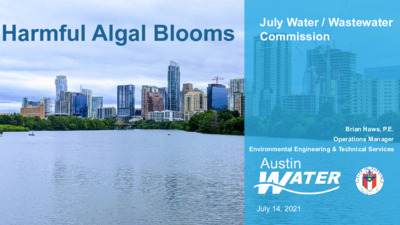E2 — original pdf
Backup

Harmful Algal Blooms July Water / Wastewater Commission Brian Haws, P.E. Operations Manager Environmental Engineering & Technical Services July 14, 2021 2 Agenda Background – Algae in the Highland Lakes Source water sampling and monitoring Austin Water analytical strategies Austin Water Harmful Algal Bloom (HAB) mitigation strategies and treatment readiness Harmful Algal Blooms July 14, 2021 Algae in the Highland Lakes Composed of photosynthesizing bacteria (cyanobacteria) 3 • some types produce toxic compounds (cyanotoxins) • a.k.a. “blue-green algae” • common in natural water Contributing Factors • Warm water • Low or stagnant flow • Abundance of nutrients Harmful Algal Blooms July 14, 2021 Planktonic vs. Benthic Algae Planktonic blooms 4 Toledo, Ohio • Free floating microscopic cells • Suspended in the water column or floating as scum on surface Benthic proliferations • Originate on bottom of lake in shallow water Lake Erie • Globs or mats remain on the bottom or float to the surface 5 Harmful Algal Blooms July 14, 2021 Detecting a HAB: Routine plankton counts at WTP intakes • Focus on blue / green totals • Observe trending • Adjust monitoring frequency based on current conditions Continuous exchange of information • Watershed Protection Department • Lower Colorado River Authority Monitoring the Source – Plankton Counts Blue Green Phytoplankton Count 2017 - present 6 60,000 50,000 40,000 30,000 20,000 10,000 ) l m / . g r o ( t n u o c n o t k n a p o t y h p l 0 Harmful Algal Blooms July 14, 2021 7 Cyanotoxin Monitoring: History Cyanotoxins are unregulated • No maximum contaminant levels (MCLs) established by EPA Austin Water first sampled in 2015 • Detected cylindrospermopsin (just above detection) at WTP intakes • No other cyanotoxin “detects” in Austin Water monitoring history Unregulated Contaminant Monitoring Rule (UCMR) sampling in 2019 (all non-detect) Harmful Algal Blooms July 14, 2021 8 Cyanotoxin Monitoring: 2021 Biweekly sampling since February 2021 Collected at intake and tap at all 3 plants All results non-detect LCRA Monitoring 9 Biweekly at Hudson Bend • Dihydroanatoxin detected in water in Mid- March o Levels just above detection • All water samples non-detect since then Sampled 12 sites in Late March • Dihydroanatoxin detected in the water at 4 sites o Levels just above detection • Future sampling o Deploying SPATT bags at multiple reservoirs o Above the dam at each reservoir 10 Watershed Protection Department Monitoring • Biweekly sampling • Ladybird Lake (3 sites) • Lake Austin (3 sites) • Cyanotoxins detected in algae only 11 Austin Water Analytical Strategies • Weekly algae counts • Evaluate trends • Compare against published triggers • FloCam purchase (July Commission) • Biweekly cyanotoxin sampling (contract lab) • Developing ELISA method at AW Water Quality Lab • Quicker turnaround at a lower cost • Method still in development Harmful Algal Bloom Mitigation Strategies 12 Adjusting monitoring frequency based on conditions Utilizing available AWWA resources Reviewing existing literature Coordinating with other agencies (APH; Watershed; LCRA; HSEM) Developing communications plans Evaluating effectiveness of treatment and operational options Participating in Water Research Foundation (WRF) study Water Treatment Plant Readiness 13 • EPA preferred method – conventional treatment • Additional treatment methods – PAC and oxidation • Retrofitting for additional chemical capabilities • Ongoing testing to confirm effectiveness of treatment methods • Engage consultants for guidance and broader perspective